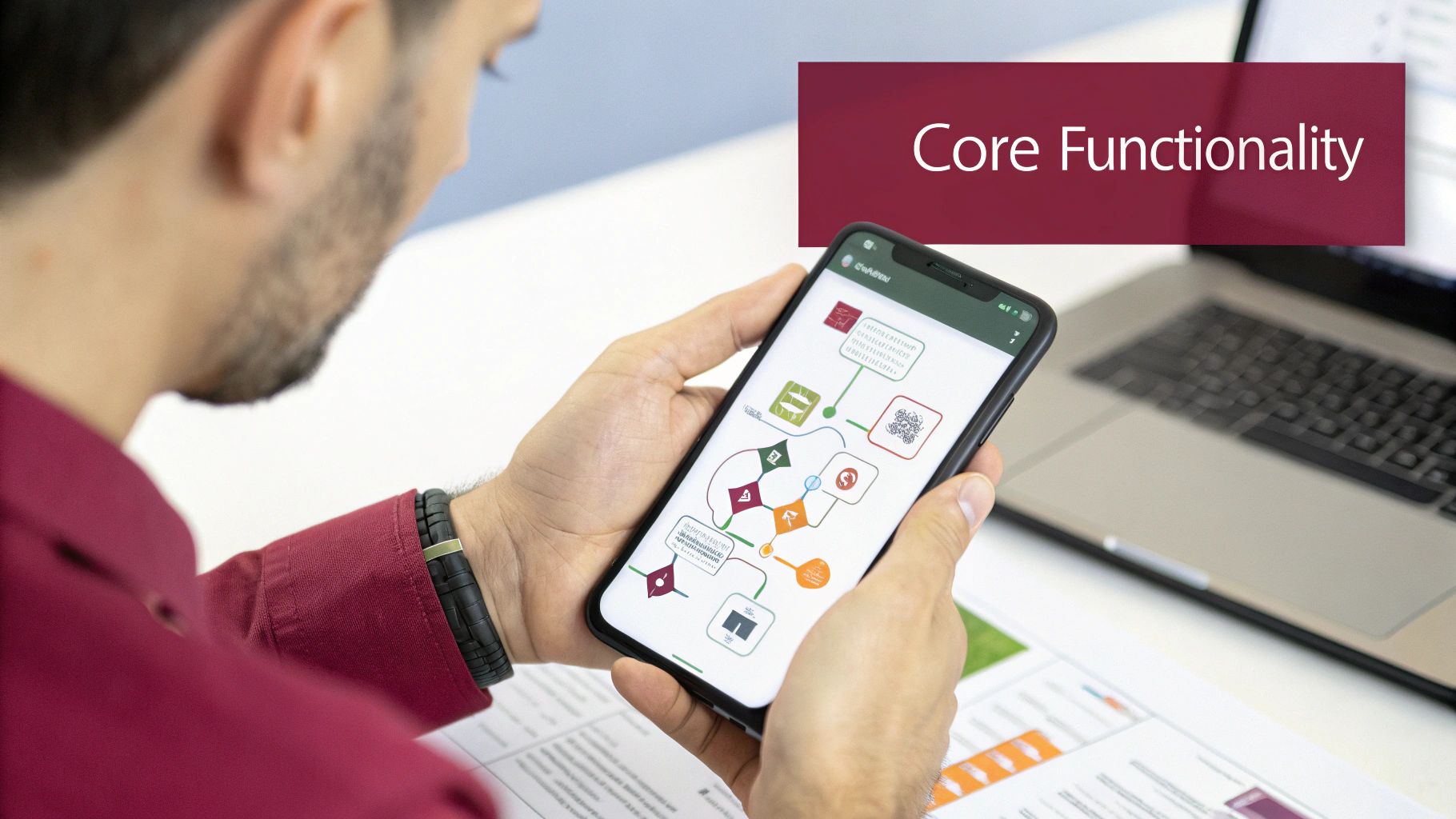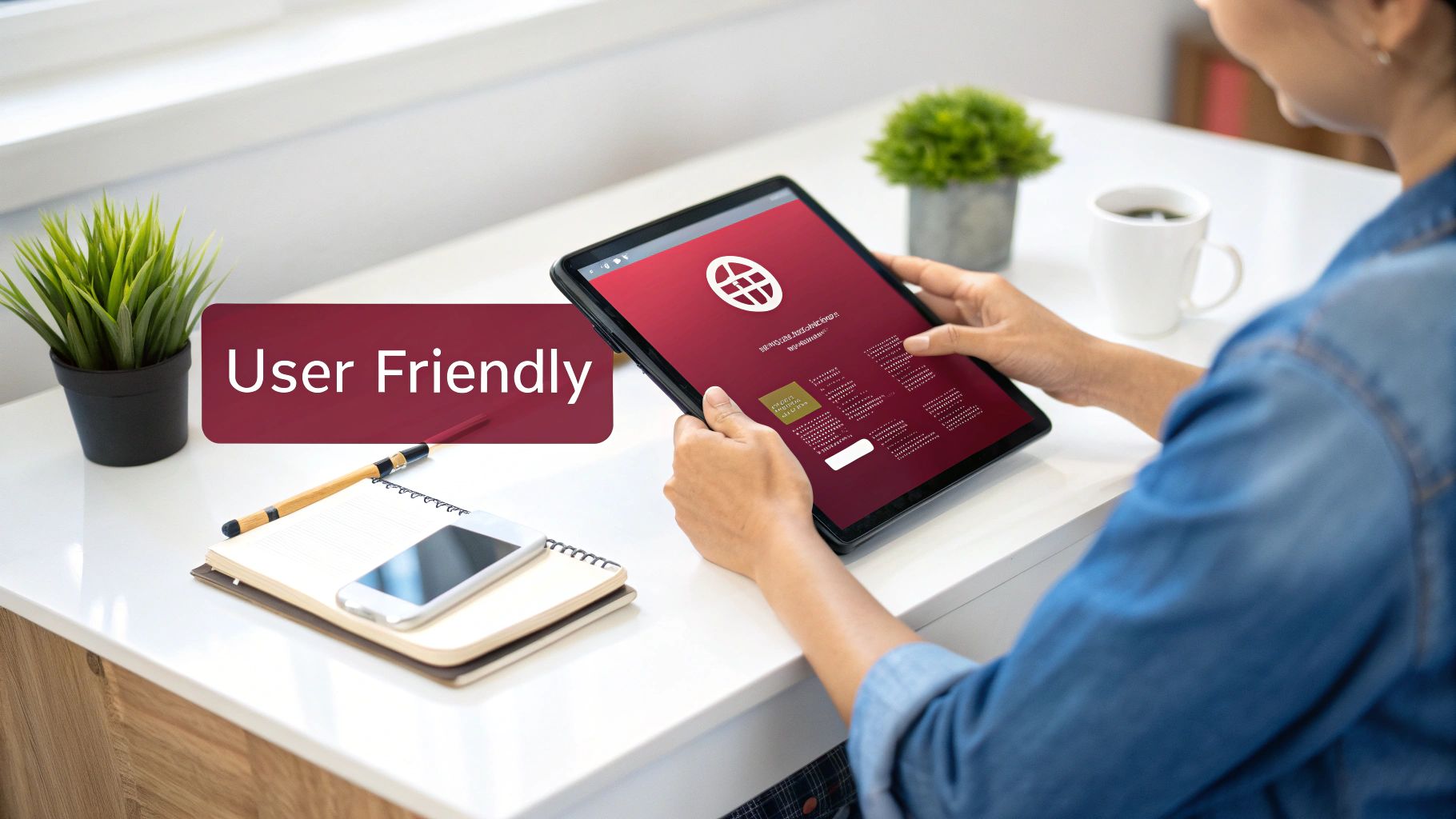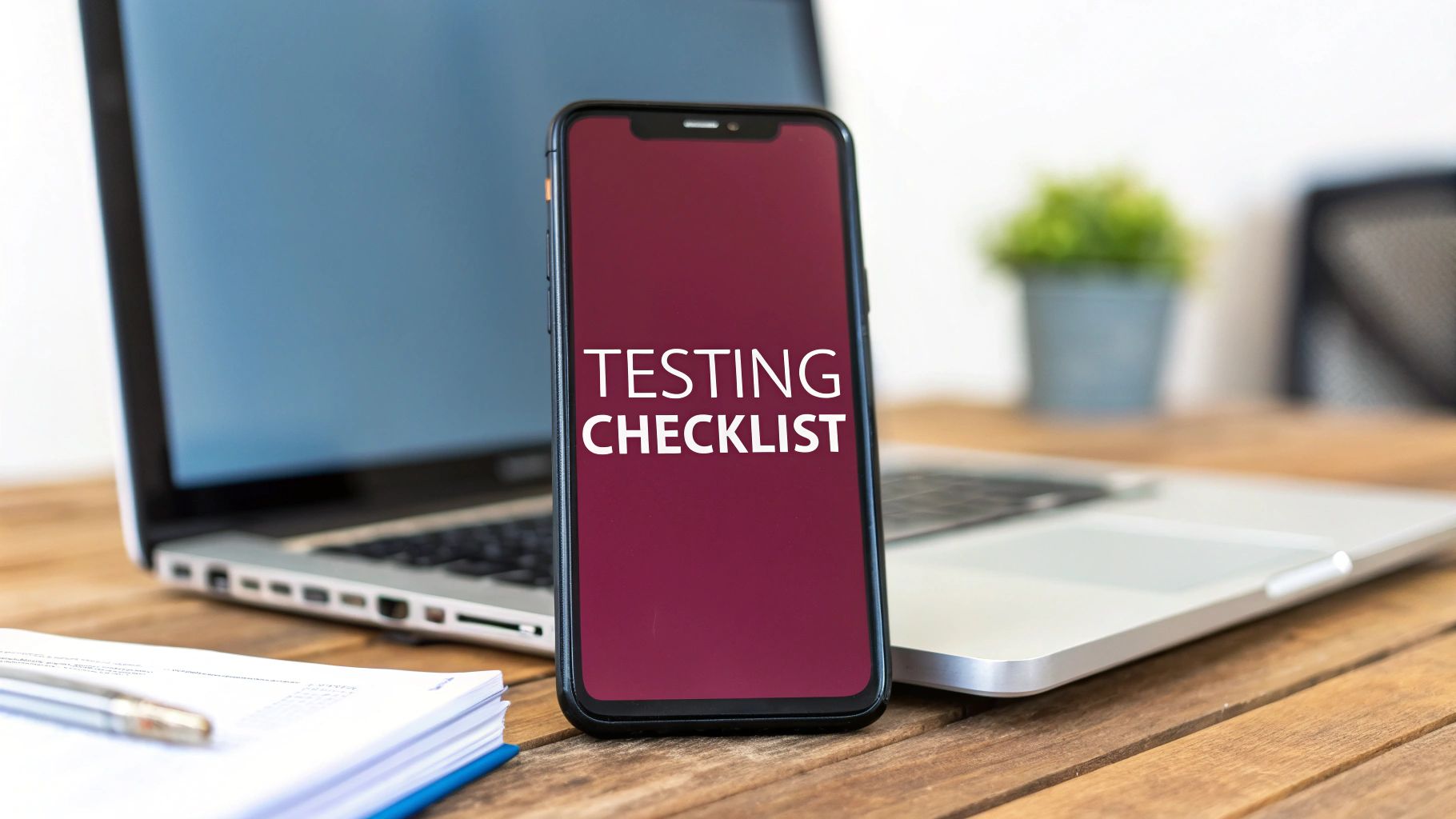Ready to Launch a Flawless App? Test It First!
Releasing a bug-free, high-performing mobile app is crucial for success. This mobile app testing checklist covers seven essential tests to perform before launch, ensuring a positive user experience and avoiding costly post-release fixes. From functional and usability testing to security and performance evaluations, this guide provides the key checks for a smooth launch. Learn how to conduct these tests and why they matter for delivering a polished product, whether you’re a React Native developer, part of a DevOps team, or a product manager.
1. Functional Testing
Functional testing is a crucial component of any mobile app testing checklist. It verifies that your app performs all its intended functions correctly, aligning with the predefined specifications. This process checks whether the application works as expected, validating everything from user flows and business logic to the correct implementation of individual features. Essentially, it answers the question: “Does the app do what it’s supposed to do?”

Functional testing focuses on several key features: core functionality validation, user flow verification, error handling assessment, integration of app components, and business logic validation. For example, core functionality validation ensures that fundamental features like login, registration, and search work flawlessly. User flow verification assesses the smoothness and logic of user journeys within the app, like completing a purchase or updating a profile. Error handling is crucial; functional testing probes how the app responds to incorrect inputs, network issues, or other unexpected events. Finally, it confirms that the app’s different components integrate seamlessly and that the underlying business logic produces the desired outcomes.
This approach deserves a top spot in your mobile app testing checklist because it directly impacts user satisfaction and business success. By catching critical bugs early in the development lifecycle, you can avoid costly fixes down the line and ensure a positive user experience. Thorough testing often reveals bugs. Accurately documenting these issues is crucial for efficient resolution. For guidance on creating effective bug reports, check out this resource: Essential Bug Reporting Best Practices. Essential Bug Reporting Best Practices: A Comprehensive Guide for Development Teams from Screendesk.
Pros of Functional Testing:
- Ensures the app meets user requirements: By focusing on the intended functionality, you guarantee the app delivers what users expect.
- Identifies critical bugs before release: Early bug detection prevents negative user reviews and costly post-release fixes.
- Validates core user journeys: Ensures users can navigate the app smoothly and accomplish their goals.
- Confirms business outcomes can be achieved: Verifies that the app supports the intended business goals, like generating leads or processing transactions.
Cons of Functional Testing:
- Can be time-consuming for complex apps: Testing every possible scenario can take significant time and resources.
- May require extensive test case creation: Thorough testing requires a detailed test matrix covering all features and scenarios.
- Doesn’t cover non-functional aspects: This testing type doesn’t address performance, security, or usability issues.
Examples of Functional Testing in Practice:
- Uber: Functional testing verifies critical functionalities like ride booking, driver assignment, payment processing, and location tracking.
- Instagram: Functional testing validates features such as photo uploading, feed rendering, comment functionality, direct messaging, and story posting.
Tips for Effective Functional Testing:
- Prioritize test cases based on user criticality: Focus on testing the most frequently used and essential features first.
- Use both positive and negative test scenarios: Test with valid and invalid inputs to ensure robust error handling.
- Test all form inputs with valid and invalid data: Verify proper validation and error messages for all input fields.
- Verify all notifications and alerts work correctly: Ensure users receive timely and accurate notifications.
- Create a comprehensive test matrix covering all features: Document all test cases and their expected results for complete coverage.
By prioritizing functional testing within your mobile app testing checklist, you significantly improve the chances of launching a high-quality, user-friendly, and successful app. This methodical approach is essential for React Native app developers, DevOps and release engineers, QA and beta testing teams, security-conscious enterprise organizations, and product managers seeking real-time insights into their app’s performance.
2. Usability Testing
Usability testing is a crucial part of any mobile app testing checklist. It evaluates how user-friendly and intuitive your mobile application is, focusing on the overall user experience. This process aims to identify any pain points in navigation, workflow, and interface design that might frustrate users or create barriers to adoption. Effectively, it answers the question: how easy is it for real users to accomplish their goals within the app? For React Native app developers, DevOps and release engineers, QA and beta testing teams, and product managers, usability testing provides invaluable insights into the user journey and helps create a more satisfying and efficient product. This is critical for boosting user retention, improving app store ratings, and minimizing costly post-release fixes.

Usability testing involves observing representative users interacting with your app, typically while completing specific tasks. Testers are encouraged to think aloud as they navigate, providing valuable qualitative feedback about their experience. This process helps uncover issues with the user interface (UI) design, the efficiency of the navigation flow, the overall intuitiveness of the app, its accessibility compliance, and ultimately, user satisfaction. For example, features like button placement, menu structures, and form design are all carefully scrutinized.
Successful implementation of usability testing can be seen in apps like Duolingo and Airbnb. Duolingo regularly conducts usability testing to refine their language learning experience, ensuring lessons are engaging and easy to follow. Similarly, Airbnb’s booking flow has been optimized through extensive usability testing, making it straightforward for users to find and reserve accommodations. These companies demonstrate how prioritizing usability can lead to a more streamlined and enjoyable user experience, ultimately contributing to their success.
Tips for Effective Usability Testing:
- Test with your target audience: Recruit participants who represent your app’s ideal users.
- Observe users completing common tasks: Focus on the core functionalities of your app and watch how users navigate them. Avoid assisting users unless absolutely necessary.
- Measure time-on-task and success rates: Collect quantitative data to identify areas where users struggle or take too long to complete actions.
- Collect both quantitative metrics and qualitative feedback: Combine hard data with user comments and observations for a comprehensive understanding.
- Test on various device sizes and operating systems: Ensure your app is responsive and functions correctly across different screens and platforms. This is particularly important for React Native developers who are building cross-platform applications.
Pros:
- Improves user satisfaction and retention
- Identifies UX issues early in the development process
- Reduces customer support requests
- Enhances app store ratings
Cons:
- Subjective elements can be difficult to quantify
- Requires representative user participants, which can be challenging to recruit
- Can be resource-intensive to conduct properly
Usability testing deserves a prominent place in any mobile app testing checklist because it directly impacts user satisfaction and app success. By focusing on the user experience, you can create an app that is not only functional but also enjoyable and easy to use. This method is particularly valuable for security-conscious enterprise organizations as a well-designed UI can minimize user errors and security vulnerabilities. While you can find more information about general data sharing policies in articles like Learn more about Usability Testing, remember to focus your research on usability testing specific to mobile applications for the most relevant insights. The principles popularized by usability experts like Jakob Nielsen and Don Norman, along with guidelines like Google’s Material Design, provide a strong foundation for conducting effective usability tests.
3. Compatibility Testing
Compatibility testing is a critical part of any mobile app testing checklist. It ensures your app functions seamlessly across a diverse range of devices, operating systems, screen sizes, and network conditions. Given the fragmented mobile ecosystem, particularly within the Android landscape, thorough compatibility testing is essential for reaching a broad audience and delivering a consistent user experience. This process involves verifying device compatibility, testing different OS versions, ensuring screen resolution and size adaptation, simulating various network conditions, and checking third-party integration compatibility. This step is indispensable for a successful mobile app launch and its continued smooth operation.

Compatibility testing works by systematically testing your app on a representative sample of target devices and configurations. This can involve using physical devices, emulators, or cloud-based device farms. Testers interact with the app on each configuration, checking for functionality, performance, and UI issues. They also simulate different network conditions (like 3G, 4G, and Wi-Fi) to ensure the app remains usable and responsive even under less-than-ideal connectivity. For React Native developers, understanding how the framework bridges platform differences is key to efficient compatibility testing – Learn more about Compatibility Testing for insights into this.
For instance, WhatsApp maintains compatibility with a wide range of Android devices, some running older OS versions like Android 4.0.3. This requires extensive compatibility testing to guarantee a consistent experience across its vast user base. Similarly, Netflix dynamically adjusts streaming quality based on device capabilities and network conditions, demonstrating effective compatibility testing in action.
Pros:
- Broader Market Reach: Compatibility testing ensures your app reaches the widest possible audience by functioning correctly on various devices and OS versions.
- Reduced Negative Reviews: By addressing device-specific issues pre-launch, you minimize negative reviews and improve your app store rating.
- Prevents Post-Launch Crises: Thorough testing avoids costly and time-consuming fixes for compatibility problems discovered after release.
- Enhanced User Satisfaction: Consistent performance across devices leads to higher user satisfaction and better engagement.
Cons:
- Time-Consuming: Testing on all possible configurations can be incredibly time-consuming, especially without automation.
- Resource Intensive: Access to a wide range of physical devices or emulators, or subscribing to device farms, can be expensive.
- Ongoing Maintenance: New devices and OS versions are constantly released, requiring ongoing maintenance and testing to ensure continued compatibility.
Tips for Effective Compatibility Testing:
- Prioritize Based on Analytics: Use your target market analytics to prioritize which devices and OS versions to test.
- Leverage Device Farms: Cloud-based device farms like AWS Device Farm or Firebase Test Lab provide access to a wide array of devices for testing.
- Create a Compatibility Matrix: Develop a compatibility matrix outlining the critical OS/device combinations to ensure comprehensive coverage.
- Test on Low-End Devices: Don’t just focus on high-end devices; testing on low-end devices is crucial to ensuring accessibility and performance for all users.
- Automate Where Possible: Automate repetitive compatibility tests to save time and resources.
This meticulous approach is especially crucial for target audiences such as React Native app developers, DevOps and release engineers, QA and beta testing teams, security-conscious enterprise organizations, and product managers needing real-time performance insights. By including compatibility testing in your mobile app testing checklist, you safeguard against fragmentation issues, ensure a positive user experience, and ultimately contribute to the success of your app in the competitive mobile market.
4. Performance Testing
Performance testing is a crucial part of any mobile app testing checklist. It evaluates how your app performs under various conditions, focusing on responsiveness, stability, battery consumption, and resource usage. This process ensures your app remains fast and reliable even under stress, such as high user load or constrained resources like low battery or limited network connectivity. Thorough performance testing helps identify and address bottlenecks before they impact the end-user experience, leading to higher user retention and fewer negative reviews.

This type of testing goes beyond simply checking functionality. It digs deeper into how efficiently the app utilizes device resources and how quickly it responds to user interactions. Features of performance testing include response time measurement, battery consumption analysis, memory usage monitoring, CPU utilization tracking, load time optimization, and network bandwidth usage. By analyzing these metrics, developers can pinpoint areas needing optimization and ensure a smooth and efficient user experience.
For example, Pokémon GO famously underwent extensive performance optimization after suffering significant server issues and crashes following its initial launch. Similarly, music streaming services like Spotify optimize streaming performance based on network conditions and device capabilities, ensuring a seamless listening experience even under fluctuating network connectivity. These examples highlight the importance of incorporating performance testing into the mobile app testing checklist.
Why Performance Testing Deserves its Place in the Checklist:
Performance is a key factor in user satisfaction. Slow, unresponsive, or battery-draining apps are quickly abandoned by users. Performance testing proactively identifies and addresses these issues, leading to:
- Improved User Retention: A smoothly performing app encourages continued use and engagement.
- Reduced Negative Reviews: Addressing performance issues preemptively minimizes negative app store reviews.
- Cost Savings: Identifying and fixing performance bottlenecks early in the development cycle is more cost-effective than addressing them post-launch.
Pros:
- Identifies performance bottlenecks before users experience them.
- Ensures app remains responsive under various conditions.
- Improves user retention (slow apps are frequently abandoned).
- Reduces negative reviews related to performance issues.
Cons:
- Requires specialized tools and expertise.
- Performance metrics can vary across devices.
- Time-consuming to test under all possible conditions.
Tips for Effective Performance Testing:
- Test performance under various network conditions (4G, 3G, weak WiFi).
- Monitor battery consumption during typical user journeys.
- Analyze memory leaks during extended use sessions.
- Measure app startup time and optimize accordingly.
- Use tools to simulate different device performance profiles.
When and Why to Use Performance Testing:
Performance testing should be integrated throughout the development lifecycle, not just as a final step. Early and continuous performance testing allows developers to catch and address issues as they arise. It’s particularly critical for apps expected to handle large amounts of data, complex interactions, or operate under varying network conditions. For React Native developers, DevOps engineers, QA teams, and product managers seeking real-time insights, performance testing is indispensable. Learn more about Performance Testing and how it can help you deliver high-performing, reliable mobile applications. This is especially relevant for security-conscious enterprise organizations where application stability and performance are paramount.
5. Security Testing
Security testing is a crucial component of any mobile app testing checklist, especially for React Native app developers, DevOps and release engineers, QA and beta testing teams, security-conscious enterprise organizations, and product managers seeking real-time insights. It’s the process of identifying vulnerabilities, threats, and risks within your mobile application that could potentially lead to data breaches, unauthorized access, or other security compromises. This testing is absolutely essential for apps that handle sensitive user data like personally identifiable information (PII), financial transactions, or medical records. Skipping this step can have devastating consequences, ranging from reputational damage to significant financial losses. This is why it deserves a prominent place in any comprehensive mobile app testing checklist.
How Security Testing Works:
Security testing employs various techniques to probe the application’s defenses. It simulates real-world attack scenarios to uncover weaknesses in the app’s security posture. This can involve analyzing the application’s code, network communication, and data storage mechanisms.
Key Features of Security Testing:
- Data encryption verification: Ensuring data is encrypted both in transit and at rest.
- Authentication and authorization testing: Validating login procedures and access control mechanisms.
- Session management assessment: Checking for vulnerabilities in how user sessions are handled.
- API security validation: Testing the security of the APIs used by the mobile app.
- Penetration testing: Simulating real-world attacks to identify exploitable vulnerabilities.
- Secure storage evaluation: Verifying that sensitive data is stored securely on the device.
Pros:
- Protects sensitive user data: Safeguards user privacy and prevents data breaches.
- Prevents costly security breaches: Reduces the risk of financial and reputational damage.
- Builds user trust and confidence: Demonstrates a commitment to security, fostering user loyalty.
- Ensures compliance with regulations: Helps meet requirements like GDPR, HIPAA, and others.
Cons:
- Requires specialized security expertise: Effective security testing often requires specialized skills and tools.
- Security threats constantly evolve: Ongoing testing is necessary to keep up with emerging threats.
- Can be difficult to balance security with usability: Implementing strong security measures can sometimes impact the user experience.
Examples of Successful Implementation:
- Banking apps like Chase: Implement multi-layered security testing, including penetration testing and vulnerability scanning, to protect financial transactions.
- Signal messenger: Prioritizes security with extensive cryptographic validation and end-to-end encryption.
Actionable Tips for Mobile App Security Testing:
- Follow OWASP Mobile Security Testing Guide (MSTG): This comprehensive guide provides best practices and methodologies for mobile app security testing.
- Test for common vulnerabilities: Focus on areas like insecure data storage, weak server-side controls, and improper authentication.
- Verify proper certificate validation and SSL pinning: Ensure secure communication between the app and the server.
- Conduct regular penetration testing: Employ ethical hackers to simulate real-world attacks.
- Implement automated security scans in CI/CD pipeline: Integrate security testing into the development process for continuous monitoring. Learn more about Security Testing to enhance the security of your live updates.
Popularized By:
- OWASP (Open Web Application Security Project)
- National Institute of Standards and Technology (NIST)
By prioritizing security testing in your mobile app testing checklist, you can significantly reduce the risk of security breaches, protect user data, and build a more trustworthy and reliable application. It is an investment that pays off in the long run by preventing potentially devastating consequences.
6. Offline Functionality Testing
Offline functionality testing is a crucial component of any mobile app testing checklist. This process verifies how your app behaves when the user has no internet connection or experiences intermittent connectivity. Robust offline functionality testing ensures a positive user experience even in challenging network conditions, making it a key consideration for React Native app developers, DevOps and release engineers, QA and beta testing teams, security-conscious enterprise organizations, and product managers seeking real-time insights.
This type of testing examines several key features:
- Offline Mode Verification: Does the app enter a dedicated offline mode gracefully, providing appropriate feedback to the user?
- Data Caching Assessment: Is data that the user needs frequently cached effectively for offline access? This could include recently viewed items, user profiles, or essential application data.
- State Persistence Validation: Does the app save the user’s current state when going offline, so they can seamlessly resume their activity when connectivity returns?
- Synchronization Testing: When the connection is restored, does the app synchronize data created or modified offline with the server correctly and efficiently? This involves handling potential conflicts effectively.
- Graceful Error Handling for Connectivity Issues: Does the app display informative error messages when actions require connectivity but it’s unavailable? Does it avoid crashing or corrupting data in these scenarios?
By thoroughly testing these aspects, you can ensure your app remains functional and user-friendly even in offline scenarios. This is especially vital for applications intended for travel, rural areas, or international use where consistent network connectivity isn’t guaranteed.
Why Offline Functionality Matters in Your Mobile App Testing Checklist
In today’s interconnected world, users expect a seamless experience regardless of their network status. Including offline functionality testing in your checklist provides several critical benefits:
Pros:
- Improved User Experience: Users can continue using core functionalities even without internet access, reducing frustration and enhancing engagement.
- Reduced User Frustration: Eliminates errors and disruptions caused by network fluctuations.
- Enables Essential Functionality: Ensures key features remain accessible, regardless of connection status.
- Critical for Specific Use Cases: Essential for apps used in areas with poor connectivity, during travel, or for international audiences.
Cons:
- Increased Development Complexity: Designing and implementing offline functionality adds complexity to the development process.
- May Require Additional Storage: Storing offline data might require more storage space on the device.
- Conflict Resolution During Sync: Handling conflicts that arise when the same data is modified both offline and online can be technically challenging.
Successful Examples of Offline Functionality
Several popular apps demonstrate successful implementations of offline functionality:
- Google Maps: Users can download maps for offline use, enabling navigation even without an internet connection.
- Spotify: Premium users can download playlists and albums for offline listening.
- Evernote: Notes created offline are automatically synchronized when the device reconnects to the internet.
Actionable Tips for Offline Functionality Testing:
- Test Transition Between Online and Offline States: Simulate real-world scenarios by repeatedly switching between online and offline modes.
- Verify Data Created Offline Properly Syncs When Online: Ensure all modifications made offline are synchronized correctly without data loss or corruption.
- Ensure Clear User Communication About Offline Status: Provide clear indicators to the user about their current connection status and the availability of offline features.
- Test with Airplane Mode and in Network Dead Zones: Test in diverse environments to replicate real-world connectivity issues.
- Validate Conflict Resolution When Same Data is Modified Offline and Online: Develop robust conflict resolution mechanisms and thoroughly test them.
Learn more about Offline Functionality Testing to gain further insights on how to effectively implement offline screens within your applications. This resource can assist you in building robust and user-friendly offline experiences.
7. Localization Testing
Localization testing is a crucial part of the mobile app testing checklist, especially for apps targeting a global audience. It verifies that your app functions correctly and provides a positive user experience across different languages, regions, and cultural contexts. This goes beyond simple text translation; it encompasses adapting your app’s entire interface and functionality to resonate with users worldwide. Failing to properly localize your app can lead to a poor user experience, negative reviews, and ultimately, limited market penetration.
How Localization Testing Works:
Localization testing involves testing various aspects of your app, including:
- Language Translation Verification: Ensuring accurate and natural-sounding translation of all text within the app, including UI elements, menus, error messages, and in-app content.
- Cultural Appropriateness Assessment: Checking that the app’s content, images, icons, and overall design are culturally sensitive and appropriate for the target market. This includes considering local customs, traditions, and sensitivities.
- Regional Format Validation: Verifying that date/time formats, currency symbols, number formats, and address formats adhere to the conventions of the target region.
- Right-to-Left Language Support: Ensuring proper display and functionality for right-to-left (RTL) languages like Arabic, Hebrew, and Persian. This requires adapting the entire UI layout.
- Content Adaptation for Local Markets: Tailoring the app’s content, features, and even payment methods to suit the specific needs and preferences of local markets.
Examples of Successful Implementation:
- Duolingo: Known for its language learning platform, Duolingo rigorously localizes its app into 40+ languages, ensuring a seamless experience for learners worldwide.
- Airbnb: This global travel platform adapts its interface to match local cultural norms and preferences, including supporting local payment methods and displaying relevant local content.
Why Localization Testing Deserves Its Place in the Checklist:
In an increasingly interconnected world, neglecting localization testing severely limits an app’s potential. By investing in thorough localization testing, you can:
- Expand Potential Market Reach Globally: Reaching a wider audience and tapping into new markets.
- Improve User Experience for International Audiences: Providing a more intuitive and engaging experience for users who don’t speak your app’s original language.
- Demonstrate Respect for Cultural Differences: Showing that you value your international users by tailoring your app to their specific needs.
- Increase App Adoption in Non-English Markets: Significantly boosting downloads and engagement in markets where English is not the primary language.
Pros and Cons of Localization Testing:
Pros:
- Significantly expands potential market reach.
- Enhances user experience for international users.
- Fosters positive brand image and demonstrates cultural sensitivity.
- Can drastically increase app downloads and revenue in global markets.
Cons:
- Increases testing complexity exponentially with each additional language.
- Requires native speakers for accurate linguistic and cultural assessment.
- UI design must be flexible to accommodate text expansion/contraction between languages.
Actionable Tips for Localization Testing:
- Test for text overflow: Ensure UI elements can accommodate text expansion in different languages. Some languages require significantly more space than others.
- Validate regional formats: Double-check that date, currency, and number formats adhere to local expectations.
- Test special characters: Verify the proper display of special characters and diacritical marks specific to different languages.
- Ensure cultural appropriateness of graphics: Confirm that graphics and icons are culturally sensitive and avoid any potentially offensive or misleading imagery.
- Test RTL layout: For right-to-left languages, ensure complete and seamless adaptation of the UI layout, including text alignment, navigation, and image placement.
When and Why to Use This Approach:
Localization testing is essential before launching your app in any new market. If you plan to target users beyond your app’s original language, localization testing should be an integral part of your development and QA process. It’s an investment that pays off by maximizing your app’s global reach and ensuring a positive experience for users worldwide. This is particularly important for React Native developers, DevOps and release engineers, QA and beta testing teams, security-conscious enterprise organizations, and product managers looking to gain real-time insights into their app’s global performance.
7-Point Mobile App Testing Checklist Comparison
| Testing Type | Implementation Complexity 🔄 | Resource Requirements 💡 | Expected Outcomes 📊 | Ideal Use Cases 💡 | Key Advantages ⭐ |
|---|---|---|---|---|---|
| Functional Testing | Medium - requires detailed test cases | Moderate - test design & tools | Validates core app functions and flows | Apps with defined business logic and UX | Ensures app meets requirements; critical bug ID |
| Usability Testing | Medium to High - involves user studies | High - need actual users & sessions | Improved user satisfaction and UX insights | Apps focusing on UX, UI, and adoption | Identifies UX issues early; boosts retention |
| Compatibility Testing | High - many device/OS combos to cover | High - multiple devices/emulators | Broad device/OS compatibility | Apps targeting diverse platforms/devices | Ensures market reach; prevents device-specific issues |
| Performance Testing | High - requires specialized tools | High - testing environments & tools | App responsiveness and stability ensured | Apps needing high performance/stability | Identifies bottlenecks; improves user retention |
| Security Testing | High - needs security expertise | High - security tools & skilled testers | Identification of vulnerabilities | Apps handling sensitive or financial data | Protects data; builds user trust; regulatory compliance |
| Offline Functionality Testing | Medium to High - complex sync logic | Moderate - network simulation tools | Reliable offline behavior and data sync | Apps used in poor/no connectivity zones | Ensures UX continuity offline; critical for remote use |
| Localization Testing | High - multiple languages and cultural checks | High - native speakers & localization tools | Proper app adaptation globally | Apps targeting international users | Expands global reach; improves local user comfort |
Ship with Confidence: Your App is Ready!
By now, you should have a comprehensive understanding of the essential elements of a robust mobile app testing checklist. From functional and usability testing to performance, security, and localization, each step plays a crucial role in ensuring a high-quality product. We’ve covered key areas like compatibility testing across different devices and operating systems, as well as offline functionality and security considerations, vital for any app, especially in security-conscious enterprise organizations. Mastering these testing approaches allows React Native developers, DevOps engineers, QA teams, and product managers to identify and resolve issues early in the development lifecycle, minimizing potential problems down the line. This proactive approach not only leads to a smoother launch and more positive user reviews but also contributes to a significantly improved return on investment. A thoroughly tested app builds user trust, encourages engagement, and ultimately drives the success of your mobile application.
A well-defined mobile app testing checklist, as discussed above, is invaluable for ensuring a successful launch and positive user experience. For React Native developers seeking further optimization in their release cycle, consider CodePushGo. Streamline your post-launch updates and hotfix deployments, bypassing lengthy app store approval processes while maintaining the quality assurance standards achieved through your meticulous testing process. Visit CodePushGo today to explore how it can complement your mobile app testing checklist and elevate your release strategy.




